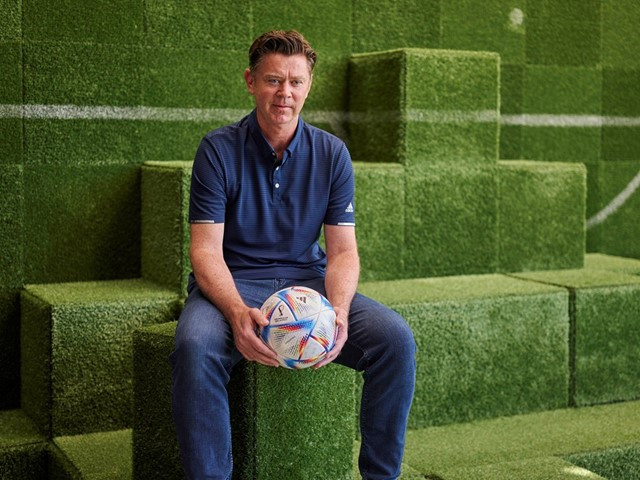Here’s a detailed look at what’s inside a football, covering its construction, the materials used, and the technology that enhances its performance.
A football is composed of multiple layers and components. These include the outer cover, lining, bladder, and sometimes embedded technology. Let’s dive in to see how all these parts function.
1. The Anatomy of a Football: A Layer-by-Layer Breakdown
A football isn’t just a simple sphere. It’s an engineered product consisting of several key components that work together to provide the required performance characteristics. These components include the outer cover, the lining, and the bladder.
1.1 The Outer Cover: Material, Texture, and Panels
The outer cover of a football is the first point of contact and therefore crucial for grip, durability, and overall feel.
- Material Composition: Football covers are generally made from leather or synthetic materials like polyurethane (PU) or polyvinyl chloride (PVC). Leather provides superior feel and performance but is more expensive and requires more maintenance. Synthetic materials are more durable, water-resistant, and cost-effective.
- Textured Surface: The surface of the football is often textured to improve grip. This texture can be achieved through various patterns, such as dimples or raised designs, which help players maintain control in different weather conditions.
- Panel Configuration: Footballs are traditionally made up of multiple panels stitched together. The number and shape of these panels can vary, affecting the ball’s aerodynamics and performance. A standard football typically has 32 panels, but variations exist.
1.2 The Lining: Enhancing Durability and Shape Retention
Beneath the outer cover lies the lining, which provides structural integrity and helps maintain the ball’s shape.
- Material Used: The lining is usually made of multiple layers of polyester or cotton fabric. These layers are cross-laminated to prevent stretching and ensure the ball retains its spherical shape over time.
- Purpose of the Lining: The lining’s primary function is to provide strength and durability to the ball. It also helps to distribute impact forces evenly, reducing the risk of deformation.
1.3 The Bladder: Air Retention and Ball Inflation
The bladder is the innermost component of a football, responsible for holding air and maintaining the ball’s pressure.
- Material Types: Bladders are typically made of butyl rubber or latex. Butyl bladders offer superior air retention, meaning the ball will stay inflated for longer periods. Latex bladders, on the other hand, provide a softer feel but require more frequent inflation.
- Inflation Valve: The bladder includes a valve that allows air to be pumped in or released. This valve is designed to be airtight, preventing air leakage during play.
2. Materials Science: Leather vs. Synthetic Footballs
The choice of materials for a football significantly impacts its performance, durability, and cost. Understanding the properties of leather and synthetic materials helps in appreciating their respective advantages and disadvantages.
2.1 The Traditional Choice: Leather Footballs
Leather footballs have been the standard for many years due to their superior feel and performance characteristics.
- Advantages of Leather:
- Enhanced Grip: Leather provides a natural grip that improves ball control, especially in dry conditions.
- Superior Feel: Many players prefer the softer feel of leather, which allows for better touch and responsiveness.
- Traditional Appeal: Leather footballs are often associated with the heritage and tradition of the sport.
- Disadvantages of Leather:
- High Cost: Leather is a more expensive material compared to synthetic alternatives.
- Maintenance Requirements: Leather requires regular conditioning and maintenance to prevent drying and cracking.
- Water Absorption: Leather can absorb water, making the ball heavier and affecting its performance in wet conditions.
2.2 The Modern Alternative: Synthetic Footballs
Synthetic footballs have gained popularity due to their durability, water resistance, and cost-effectiveness.
- Advantages of Synthetic Materials:
- Durability: Synthetic materials like PU and PVC are highly resistant to abrasion and wear, making them ideal for prolonged use.
- Water Resistance: Synthetic footballs do not absorb water, maintaining consistent weight and performance in wet conditions.
- Cost-Effectiveness: Synthetic materials are generally less expensive than leather, making synthetic footballs more affordable.
- Disadvantages of Synthetic Materials:
- Reduced Grip: Synthetic materials may not offer the same level of grip as leather, especially in dry conditions.
- Different Feel: Some players find the feel of synthetic materials less appealing compared to leather.
- Environmental Concerns: The production of synthetic materials can have environmental impacts, although advancements are being made to create more sustainable options.
3. The Manufacturing Process: From Raw Materials to Finished Product
The creation of a football involves a complex manufacturing process that combines skilled craftsmanship with modern technology.
3.1 Cutting and Preparing the Panels
The first step in manufacturing a football is cutting the outer cover material into precise panels.
- Precision Cutting: Whether using leather or synthetic materials, the panels must be cut with high precision to ensure a consistent shape and size. Automated cutting machines are often used to achieve this accuracy.
- Panel Preparation: After cutting, the edges of the panels are skived (thinned) to reduce bulk and create a smooth seam when stitched together.
3.2 Stitching the Panels Together
Stitching the panels together is a critical step that requires skilled craftsmanship.
- Hand Stitching vs. Machine Stitching: Traditionally, footballs were hand-stitched, which allowed for greater precision and durability. Today, many footballs are machine-stitched to increase production speed and reduce costs.
- Stitch Quality: The quality of the stitching is crucial for the ball’s durability and performance. Tight, even stitches prevent the seams from splitting and ensure the ball retains its shape.
3.3 Inserting the Lining and Bladder
Once the outer cover is stitched together, the lining and bladder are inserted.
- Lining Application: The lining is carefully applied to the inside of the outer cover, providing structural support and shape retention.
- Bladder Insertion: The deflated bladder is inserted through a small opening in one of the panels. The opening is then stitched closed, ensuring the bladder is securely held in place.
3.4 Inflation and Quality Control
The final steps involve inflating the ball and conducting quality control checks.
- Inflation Process: The ball is inflated to the specified pressure, and the valve is checked for leaks.
- Quality Control: Each football undergoes rigorous quality control checks to ensure it meets the required standards for size, weight, shape, and performance.
4. Technological Innovations in Modern Footballs
Modern footballs have seen significant technological advancements aimed at improving performance, accuracy, and data collection.
4.1 Connected Ball Technology: Enhancing VAR System
One of the most significant innovations is the integration of connected ball technology.
- Sensor Integration: Connected ball technology involves embedding a sensor inside the football. This sensor can track various parameters, such as ball speed, spin, and location.
- Data Transmission: The data collected by the sensor is transmitted wirelessly to a central system, providing real-time information to match officials.
- VAR Enhancement: Connected ball technology enhances the Video Assistant Referee (VAR) system by providing accurate ball data, helping officials make faster and more informed decisions.
 Holger Kraetschmer – Head of Consumer Foresight, adidas
Holger Kraetschmer – Head of Consumer Foresight, adidas
4.2 Aerodynamic Design: Improving Flight Characteristics
Aerodynamic design plays a crucial role in the flight characteristics of a football.
- Panel Shape and Configuration: The shape and arrangement of the panels can affect the ball’s drag and lift, influencing its trajectory and stability.
- Surface Texture: The texture of the ball’s surface can also impact its aerodynamics. Dimples or other surface features can help reduce drag and improve flight consistency.
4.3 Material Innovations: Enhancing Performance and Durability
Material science continues to drive innovation in football design.
- Advanced Polymers: New polymers are being developed that offer improved grip, durability, and water resistance.
- Sustainable Materials: There is a growing focus on using sustainable materials in football production, reducing the environmental impact of the sport.
5. Understanding Football Regulations: Size, Weight, and Pressure
Football regulations set standards for size, weight, and pressure to ensure fair play and consistent performance.
5.1 FIFA Standards for Footballs
FIFA (Fédération Internationale de Football Association) sets the standards for footballs used in official matches.
- Size and Shape: A regulation football must be spherical and have a circumference of 68 to 70 cm (27 to 28 inches).
- Weight: The weight of the football must be between 410 and 450 grams (14 to 16 ounces).
- Pressure: The ball’s pressure must be between 0.6 and 1.1 bar (8.7 and 16.0 psi) at sea level.
5.2 Impact of Regulations on Performance
These regulations ensure that all footballs used in official matches meet a minimum standard of quality and performance.
- Fair Play: Consistent size and weight ensure that all players have the same experience with the ball, promoting fair play.
- Predictable Performance: Regulated pressure ensures that the ball behaves predictably, allowing players to develop consistent techniques.
6. The Role of Research and Development in Football Design
Research and development (R&D) play a vital role in advancing football design and technology.
6.1 Collaboration with Universities and Research Institutions
Many football manufacturers collaborate with universities and research institutions to study ball dynamics, materials science, and player interaction.
- Ball Dynamics: Researchers use advanced techniques, such as wind tunnel testing and computational fluid dynamics (CFD), to study the aerodynamics of footballs.
- Materials Science: Scientists develop and test new materials to improve grip, durability, and water resistance.
- Player Interaction: Studies are conducted to understand how players interact with the ball, informing design decisions that enhance performance.
6.2 Impact of R&D on Football Evolution
R&D efforts have led to significant improvements in football design over the years.
- Improved Aerodynamics: R&D has resulted in footballs with more predictable flight characteristics, allowing players to execute more precise passes and shots.
- Enhanced Durability: New materials and construction techniques have made footballs more durable, extending their lifespan and reducing the need for replacements.
- Technological Integration: R&D has enabled the integration of advanced technologies, such as connected ball technology, enhancing the sport in new ways.
7. Maintaining Your Football: Tips for Longevity and Performance
Proper maintenance is essential for prolonging the life of your football and maintaining its performance.
7.1 Proper Inflation and Storage
Maintaining the correct inflation pressure and storing the ball properly can prevent damage and prolong its lifespan.
- Inflation Pressure: Always inflate the football to the manufacturer’s recommended pressure. Over-inflation can stretch the outer cover and damage the bladder, while under-inflation can affect the ball’s performance.
- Storage Conditions: Store the football in a cool, dry place away from direct sunlight and extreme temperatures. Avoid storing the ball in a compressed state, as this can deform its shape.
7.2 Cleaning and Conditioning
Regular cleaning and conditioning can help maintain the outer cover’s grip and prevent cracking.
- Cleaning: Clean the football regularly with a damp cloth to remove dirt and debris. Avoid using harsh chemicals or abrasive cleaners, as these can damage the outer cover.
- Conditioning: For leather footballs, apply a leather conditioner periodically to keep the leather supple and prevent drying.
7.3 Inspecting for Damage
Regularly inspect the football for signs of wear and tear, such as cuts, tears, or loose stitching.
- Seam Integrity: Check the seams for loose or broken stitches. If necessary, have the seams repaired by a professional.
- Outer Cover Condition: Inspect the outer cover for cuts, tears, or abrasions. Small damages can be repaired, but severe damage may require replacing the ball.
8. The Future of Football Design: What’s Next?
The future of football design promises even more exciting innovations and advancements.
8.1 Sustainable Materials and Production
There is a growing focus on developing sustainable materials and production processes for footballs.
- Bio-Based Materials: Researchers are exploring the use of bio-based materials, such as plant-based polymers, to reduce the environmental impact of football production.
- Recycling Programs: Efforts are being made to develop recycling programs for footballs, allowing old balls to be repurposed into new products.
8.2 Enhanced Sensor Technology
Advancements in sensor technology will enable even more detailed data collection and analysis.
- Improved Accuracy: New sensors will provide more accurate measurements of ball speed, spin, and location.
- Expanded Data Collection: Sensors may be able to collect additional data, such as impact forces and player biometrics.
8.3 Smart Footballs for Training and Performance Analysis
Smart footballs that provide real-time feedback to players and coaches are likely to become more prevalent.
- Performance Tracking: Smart footballs can track a player’s performance metrics, such as pass accuracy, shot speed, and ball control.
- Training Feedback: The data collected by smart footballs can be used to provide personalized training feedback, helping players improve their skills.
9. The Cultural and Economic Impact of Footballs
Footballs have a significant cultural and economic impact around the world.
9.1 Football as a Global Sport
Football is the most popular sport in the world, with billions of fans and players across the globe.
- Global Reach: Football is played in virtually every country, transcending cultural and linguistic barriers.
- Community Building: Football brings people together, fostering a sense of community and shared identity.
9.2 The Football Industry
The football industry is a multi-billion dollar market, encompassing everything from equipment and apparel to broadcasting rights and sponsorships.
- Equipment Sales: Football equipment, including footballs, generates significant revenue for manufacturers and retailers.
- Sponsorships: Football clubs and tournaments attract lucrative sponsorships from major brands.
9.3 The Role of Football in Society
Football plays an important role in society, promoting physical activity, teamwork, and social inclusion.
- Physical Health: Playing football provides numerous physical health benefits, such as improved cardiovascular fitness and muscle strength.
- Teamwork and Cooperation: Football teaches valuable teamwork and cooperation skills, helping players learn to work together towards a common goal.
- Social Inclusion: Football can be a powerful tool for social inclusion, bringing together people from diverse backgrounds and promoting understanding and respect.
10. FAQ About Footballs
Here are some frequently asked questions about footballs:
Q1: What are footballs made of?
Footballs are typically made of leather or synthetic materials like polyurethane (PU) or polyvinyl chloride (PVC). They also include a lining made of polyester or cotton and a bladder made of butyl rubber or latex.
Q2: How much does a football weigh?
A regulation football weighs between 410 and 450 grams (14 to 16 ounces).
Q3: What is the circumference of a football?
The circumference of a regulation football is between 68 and 70 cm (27 to 28 inches).
Q4: How much pressure should a football have?
A football should be inflated to a pressure between 0.6 and 1.1 bar (8.7 and 16.0 psi) at sea level.
Q5: How do I maintain my football?
To maintain your football, keep it properly inflated, clean it regularly with a damp cloth, and store it in a cool, dry place away from direct sunlight.
Q6: What is connected ball technology?
Connected ball technology involves embedding a sensor inside the football to track various parameters, such as ball speed, spin, and location.
Q7: What are the benefits of leather footballs?
Leather footballs offer enhanced grip, superior feel, and a traditional appeal.
Q8: What are the benefits of synthetic footballs?
Synthetic footballs are durable, water-resistant, and cost-effective.
Q9: How are footballs made?
Footballs are made through a process that includes cutting and preparing the panels, stitching the panels together, inserting the lining and bladder, and inflating the ball.
Q10: What is the future of football design?
The future of football design includes sustainable materials, enhanced sensor technology, and smart footballs for training and performance analysis.
Navigating the world of sports equipment can be challenging, but CAUHOI2025.UK.COM is here to help. We provide clear, reliable answers to your questions, making it easier to find the information you need.
Ready to dive deeper? Visit CAUHOI2025.UK.COM today to explore more topics or ask your own questions. You can also reach us at Equitable Life Building, 120 Broadway, New York, NY 10004, USA, or call us at +1 (800) 555-0199. We’re here to help you stay informed and make the best decisions. Find trusted answers and expert insights at CauHoi2025.UK.COM – your reliable source for everything you need to know about sports equipment and beyond.

